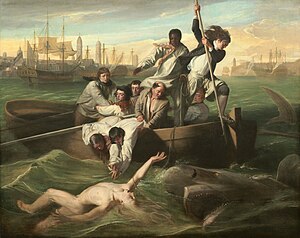Watson and the Shark
| Watson and the Shark | |
|---|---|
 |
|
| Artist | John Singleton Copley |
| Year | 1778 |
| Medium | Oil on canvas |
| Dimensions | 182.1 cm × 229.7 cm ( 71 3⁄4 in × 90 1⁄2 in) |
| Location | National Gallery of Art, Washington, D.C. |
Watson and the Shark is a 1778 oil painting by American painter John Singleton Copley, depicting the rescue of Englishman Brook Watson from a shark attack in Havana, Cuba. The original of three versions by Copley is in the National Gallery of Art, Washington, D.C., United States.
The painting is based on an attack that took place in Havana harbour in 1749. Brook Watson, then a 14-year-old cabin boy, lost his leg in the attack and was not rescued until the third attempt, which is the subject of the painting. Watson went on to become a Lord Mayor of London.
Copley and Brook Watson became friends after the American artist arrived in London in 1774. Watson commissioned him to create a painting of the 1749 event, and Copley produced three versions. It was the first of a series of large-scale historical paintings that Copley would concentrate on after settling in London. The painting is romanticised: the gory detail of the injury is hidden beneath the waves, though there is a hint of blood in the water. The figure of Watson is based on the statue of the "Borghese Gladiator", by Agasias of Ephesus, in the Louvre. Other apparent influences are Renaissance art, and the ancient statue of Laocoön and his Sons, which Copley may have seen in Rome. Copley was probably also influenced by Benjamin West's The Death of General Wolfe, and the growing popularity of romantic painting.
The composition of the rescuers in the boat shows hints of Peter Paul Rubens's Jonah Thrown into the Sea, and both Rubens's Miraculous Draught of Fishes and Raphael's painting of the same name. The facial expressions show a marked resemblance to those in Charles Le Brun's Conférence de M. Le Brun sur l'expression générale et particulière, an influential work published in 1698; they portray a range of emotions, from fear to courage. Various elements of composition were changed as the painting progressed. Infrared analysis shows that the old boatswain was originally a young man, and preliminary sketches reveal that the black sailor at the rear of the boat, who also appears as the subject of Copley's Head of a Negro painted around the same time, was originally envisioned as a white man with long, flowing hair.
...
Wikipedia
